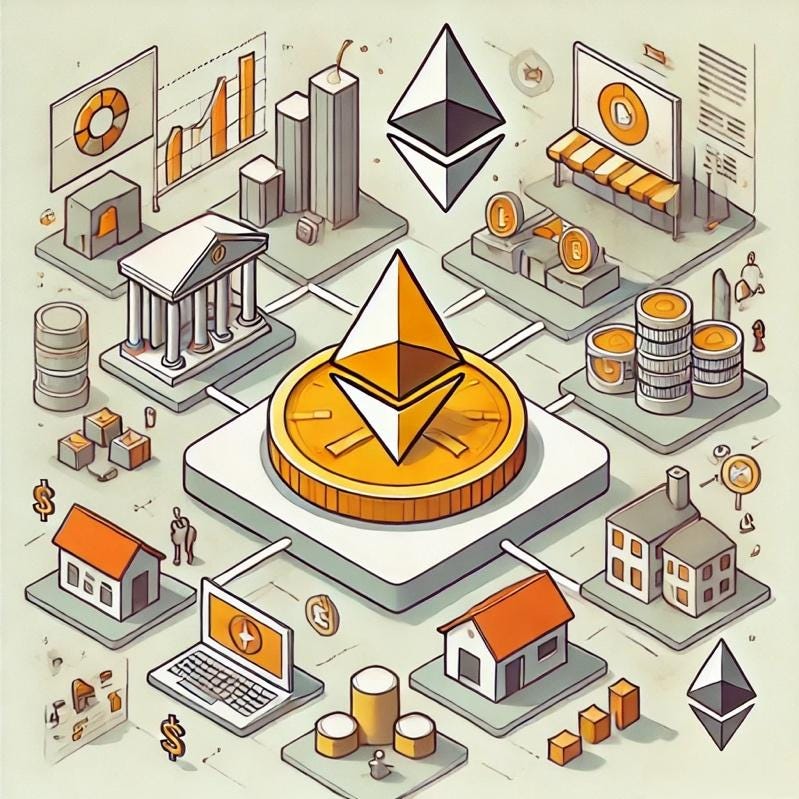🕹️ 2018 vs 2024 : What’s changed in the tokenisation game ?
5 Questions to check the fundamentals of your Web3 project
Today's Agenda...
The Director of CrunchSpark explains the major differences between 2018 and 2024 in tokenising Real-World Assets, highlighting progress in regulations, infrastructure, and institutional interest. ⚖️🔗
5 questions to ensure your Web3 project is built on solid fundamentals 🛠️📈
⏰ Reading Time: 7 min
Join the Web3 Leaders Community
🔗 Tokenising Real-World Assets : Lessons from 2018 & the road beyond 2024 🚀
This article was written by Raymond Shuai, Founder of CrunchSpark, a firm providing tailored CFO advisory and accounting services for Web3 and blockchain scale-up businesses.
In 2018, I co-founded a venture aimed at tokenising private equity and real estate. Our mission was ambitious: to transform traditionally illiquid assets into liquid, tradable tokens. Backed by CLSA, the Asian investment bank, we branded our effort "Baikal"—a reference to the world’s deepest freshwater lake, symbolising the liquidity and transparency we sought to bring to opaque markets.
Our project benefitted from access to top-tier investors, deal flow, and CLSA’s distribution network. We saw ourselves as pioneers, responsible actors taking a regulatory-first approach in a nascent sector. We built teams in Hong Kong and Singapore to secure licences and develop the platform and championed the widely held promises of tokenisation: unlocking liquidity, improving operational efficiency, reducing costs, and enabling fractional ownership to broader markets.
Yet enthusiasm soon met with reality. A significant gap existed between the perspectives of technologists and buy side investors. While we believed we were shaping the future of finance, investors remained sceptical.
Fast forward to 2024, and tokenising real-world assets (RWAs) is once again gaining prominence as the crypto industry shifts from speculative tokens and digital art to tangible, real-world assets.
At CrunchSpark, we are working with clients developing tokenisation solutions, including CADMOS and Fusang. Now seems an appropriate time to reflect on the lessons of 2018 and assess whether the current market is ready for widespread adoption.
The 2018 Challenges
Several critical obstacles impeded meaningful institutional acceptance, hindering the technology's ability to gain traction.
Regulatory Ambiguity: Regulatory frameworks for digital assets were, at best, unclear. Tokenised assets straddled the divide between traditional financial instruments and digital assets, with no specific and clear guidance on how they should be treated. This uncertainty made institutional investors hesitant to commit capital.
Underdeveloped Infrastructure: The infrastructure for handling digital assets was still in its infancy. Custodial services, a cornerstone of institutional trust, were rudimentary, while high-profile hacks only reinforced the prevailing insecurity surrounding blockchain. This diminished investor confidence further.
Limited Asset Appeal: Early tokenisation efforts often resembled proof-of-concept exercises more than genuine investment opportunities. The assets on offer lacked the yield or returns needed to attract investors, while fractionalised ownership structures introduced complexities in governance and decision-making, often to the detriment of the underlying asset.
Legal Complexities: Tokenising assets like private equity secondaries required the dissection of intricate agreements between parties (e.g., right of first refusal clauses). Such complexities cannot be solved with technology, making a one-size-fits-all approach impractical.
Risk Aversion: Blockchain’s association with speculative cryptocurrencies worked against it. Promised benefits such as fractional ownership and T+0 settlements did not resonate with conservative investors, whose focus remained firmly on regulatory clarity, security, and trust, all areas that had yet to be adequately addressed.
The Market Today
Notable progress has been made, and today’s environment for tokenising RWAs is more favourable. However, the landscape is still evolving, and several significant challenges remain.
Regulatory Frameworks: Key jurisdictions have introduced clearer guidelines for digital assets, providing the regulatory certainty that was lacking in 2018. However, cross-border tokenisation projects continue to navigate a fragmented regulatory environment, making large-scale adoption far from seamless.
Technical Infrastructure: The underlying technology has matured, with layer-2 solutions improving scalability and reducing transaction costs. Institutional custodial solutions have been adopted by large financial players, helping to build trust. Yet technical risks persist, particularly for conservative investors wary of security breaches and diverging from established processes.
Institutional Engagement: The involvement of major financial institutions such as JPMorgan and BlackRock, and the approval of ETFs, are promising signs. Nevertheless, large-scale institutional deployment remains cautious, contingent on continued technological and regulatory developments.
Investor Education: Most investors and financial advisers remain hesitant due to limitations in their understanding of the technology and the user experience challenges that persist, even with basic tasks like making a transaction via a wallet.
Alternative Asset Demand: In the context of current market volatility, tokenised assets present an opportunity for investors to diversify their portfolios.
Conclusion: A Time to Build
In hindsight, our 2018 venture was ahead of its time. While the concept of tokenisation was sound, the necessary infrastructure, regulatory clarity, and market readiness were lacking. Today, many of those early challenges have been addressed, and the market is more receptive to exploring this technology.
Yet, while the infrastructure and tools to bridge blockchain and traditional finance have matured, significant work remains. Regulatory frameworks continue to evolve and remain fragmented across jurisdictions. Technical risks, although mitigated, have not been eliminated. Institutional trust will only be earned through demonstrable security, reliability, and consistent long-term performance.
The potential for tokenisation to transform real-world assets is real. However, success will depend not just on technological advancement, but on careful execution of robust regulations and securing sustained buy-in from both institutional and retail investors. The path forward is promising but will require patience and perseverance.
You can learn more about CrunchSpark's work by visiting their website. Additionally, you can book a complimentary one-to-one consultation to discuss how they can support your business by clicking here to schedule a meeting :
*Commercial partnership
5 Questions to ask yourself to check the fundamentals of your Web3 project
It’s challenging for a project to strike the right balance between communication efforts (which often serve short-term token valuation) and technological development (something we all love in this industry). However, in doing so, it’s easy to lose sight of the most important goal: delivering real value to customers with a long-term perspective. Here are five key questions to determine if your project is avoiding the most common pitfalls.
Are we aligned with regulatory requirements? Regulations around blockchain and crypto are evolving quickly. Are you aware of the legal frameworks in your target regions, like the MiCA regulations in Europe or the SEC guidelines in the U.S.? Non-compliance could lead to legal issues that may derail your project.
Are we building beyond token price? Is your project overly focused on the token’s market value? While the price of your token can be a reflection of market sentiment, the real measure of success lies in the utility and value proposition of your platform. Does your product solve a real problem, or is it built on speculation?
Is our user experience simple and accessible? Web3 technologies can be daunting, and complexity is a barrier to adoption. Does your project make the user journey as seamless as possible? Are you simplifying processes like wallet creation and security, or are you still relying on clunky systems like 12-word seed phrases that intimidate newcomers?
Have we invested enough in security? With security breaches rampant in the blockchain space, have you prioritized safety protocols like smart contract audits? Ensuring your platform is secure builds trust and longevity, especially in a decentralized environment where hacks can happen anytime.
Is our project built for interoperability? Is your platform built as a closed ecosystem, or does it allow for interoperability with other blockchain networks? Projects that can seamlessly integrate with other platforms are more likely to scale and attract a broader user base.
By answering these questions, you can ensure that your Web3 project is not only innovative but also grounded in strong fundamentals that will support its growth and sustainability.
If you like our work, feel free to like and comment.
Follow us on Linkedin to keep up with all our news.
Disclaimer : The goal of this newsletter is to inform and produce content related to management in the world of Web3. It is not investment advice. Investments in crypto-assets and NFTs are risky and can result in the loss of your entire capital. Always conduct your own research and exercise caution.








